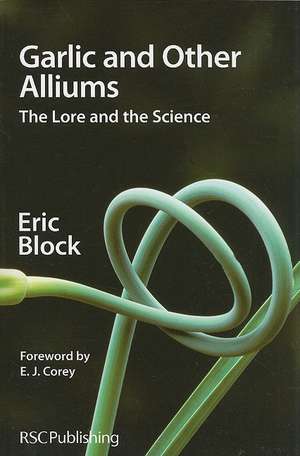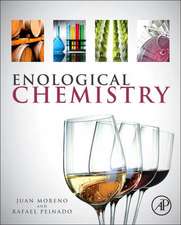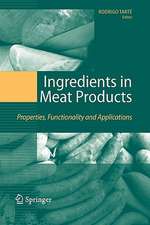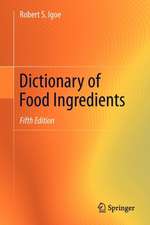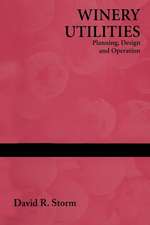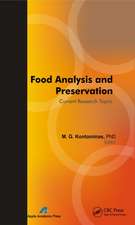Garlic and Other Alliums
Autor Eric Blocken Limba Engleză Paperback – 30 apr 2010
The name "Allium" is said to come from the Greek word to avoid because of its offensive smell. The genus Allium includes more than 800 species of which only a few have been cultivated as foods. Many of the other members of this genus are popular with gardeners as easy to maintain perennials, although the smell of some members of the genus can be off-putting. The smell is a consequence of breakdown of sulfur-containing compounds which is a characteristic of this family of plants. Garlic, onions, leeks, chives and other members of the genus Allium occupy a unique position both as edible plants and herbal medicines, appreciated since the dawn of civilization. Alliums have been featured through the ages in literature, where they are both praised and reviled, as well as in architecture and the decorative arts. Garlic pills are top-selling herbal supplements while garlic-based products show considerable promise as environmentally friendly pesticides. The remarkable properties of the alliums can be understood based on the occurrence of a number of relatively simple sulfur-containing chemical compounds ingeniously packaged by nature in these plants. This unique book, with a foreword by 1990 Nobel Laureate E.J. Corey, outlines the extensive history and the fascinating past and present uses of these plants, sorting out fact from fiction based upon detailed scrutiny of historic documents as well as numerous laboratories studies. Readers will be entertained and educated as they learn about early cultivation of garlic and other alliums while being introduced to the chemistry and biochemistry. They will learn how alliums have been portrayed and used in literature, poetry, the arts and how alliums are featured in the world's oldest cookbook. Technical material is presented in a manner understandable to a general audience, particularly through the use of illustrations to simplify more difficult concepts and explain how experimental work is conducted. The book is heavily illustrated with examples of alliums in art, literature, agriculture, medicine and other areas and includes rare botanical drawings of many members of the genus Allium. Essential reading for anyone with a general interest in science, the book is written at a level accessible to experts and non-experts alike. It has sufficient additional detail and references to satisfy both those wanting to know more, as well as researchers in disciplines as diverse as archaeology, medicine, ecology, pharmacology, food and plant sciences, agriculture, and organic chemistry.
Preț: 195.05 lei
Nou
Puncte Express: 293
Preț estimativ în valută:
37.33€ • 38.83$ • 31.28£
37.33€ • 38.83$ • 31.28£
Carte disponibilă
Livrare economică 20 februarie-06 martie
Livrare express 06-12 februarie pentru 34.39 lei
Preluare comenzi: 021 569.72.76
Specificații
ISBN-13: 9781849731805
ISBN-10: 1849731802
Pagini: 454
Ilustrații: 130 colour illustrations
Dimensiuni: 152 x 226 x 23 mm
Greutate: 0.64 kg
Ediția:Edition.
Editura: RSC Publishing
ISBN-10: 1849731802
Pagini: 454
Ilustrații: 130 colour illustrations
Dimensiuni: 152 x 226 x 23 mm
Greutate: 0.64 kg
Ediția:Edition.
Editura: RSC Publishing
Cuprins
1. Allium Botany and Cultivation, Ancient and Modern; 2. All Things Allium: Alliums in Literature, the Arts and Culture; 3. Allium Chemistry 101: Historical Highlights, Fascinating Facts and Unusual Uses for Alliums; 4. Chemistry in a Salad Bowl: Allium Chemistry and Biochemistry 5. Alliums in Folk and Complementary Medicine 6. Alliums in the Environment: Allelopathy and Allium-Derived Attractants, Antibiotics, Herbicides, Pesticides and Repellents
Recenzii
This book brings to mind the poet Horace’s formula for successful writing: He wins every hand who mingles profit with pleasure, by delighting and instructing the reader at the same time. Eric Block has certainly mixed the useful and the sweet in his book. I started Block’s book as a reviewer and became an admirer. A book that contributes so richly to my teaching and understanding of chemistry is a rare pleasure.
Notă biografică
Eric Block, Carla Rizzo Delray Distinguished Professor of Chemistry at the University at Albany, State University of New York, received a B.S. in chemistry from Queens College of the City University of New York and an M.S. and Ph.D. in chemistry from Harvard University with 1990 Nobel Laureate E.J. Corey. Prior to coming to Albany he was Professor of Chemistry at the University of Missouri-St. Louis and he has been a Visiting Professor at Harvard University, the Universities of Illinois-Urbana, Frankfurt, and Bologna, the Weizmann Institute of Science and Visiting Fellow at Wolfson College, Cambridge University. Recipient of a John Simon Guggenheim Fellowship (1984), the ACS Award for Advancement of Application of Agricultural and Food Chemistry (1987), the International Council on Main Group Chemistry Award for Excellence in Main Group Chemistry Research (1994) and the Kenneth C. Spencer Award of the Kansas City Section of the ACS (2003), Block is the author of more than 220 papers, 5 patents, 4 books, and is a member of the editorial advisory board of the Journal of Agricultural and Food Chemistry. He is known for his discoveries elucidating the natural products chemistry of Allium species (garlic, onion, etc.) accomplished over a period of 35 years including: determination of the structure of the lachrymatory factor of the onion and its dimer; identification and synthesis of "ajoene" and vinyldithiins, anticoagulants from garlic, and bis-sulfine, cepaenes, and zwiebelanes, biologically active onion flavorants; identification of organoselenium compounds in Allium volatiles and in human garlic breath; identification of trace level Allium selenoamino acids; development of analytical methods for identification of Allium organosulfur flavor components. He co-authored a clinical trial of the effectiveness of garlic and garlic supplements as lipid-lowering agents and is researching applications of garlic-derived compounds as environmentally benign pesticides.
Textul de pe ultima copertă
Garlic, onions, leeks, chives and other members of the genus Allium occupy a unique position both as edible plants and herbal medicines, appreciated since the dawn of civilization. Alliums have been featured through the ages in literature, where they are both praised and reviled, as well as in architecture and the decorative arts. Garlic pills are top-selling herbal supplements, while garlic-based products show considerable promise as environmentally friendly pesticides. The remarkable properties of the alliums can be understood based on the occurrence of a number of relatively simple sulfur-containing chemical compounds ingeniously packaged by nature in these plants. An appreciation for the novel way nature equips plants to survive and thrive by chemical means is described in the quotation from famed ethnobotanist Richard Schultes: "Plants live by their chemical wits.". This book helps the reader judge the accuracy of numerous claims regarding the health benefits of garlic. This unique book outlines the extensive history and the fascinating past and present uses of these plants, sorting out fact from fiction based upon detailed scrutiny of historic documents as well as numerous laboratories studies. Readers will be entertained and educated as they learn about early cultivation of garlic and other alliums while being introduced to their remarkable chemistry and biochemistry, much of which prominently features the element sulfur. They will learn how alliums have been portrayed and used in literature, poetry and the arts and how alliums are featured in the world's oldest cookbook. Technical material is presented in a manner understandable to a general audience, particularly through the use of illustrations to simplify more difficult concepts and explain how experimental work is conducted. The book is heavily illustrated with examples of alliums in art, literature, agriculture, medicine and other areas and includes rare botanical drawings of many members of the genus Allium. Essential reading for anyone with an interest in science, the book is written at a level accessible to experts and nonexperts alike. It has sufficient additional detail and references to satisfy both the general reader wanting to know more and the professional researcher in disciplines as diverse as archaeology, medicine, ecology, pharmacology, food and plant sciences, agriculture, and organic chemistry. Garlic and Other Alliums explains the remarkable role played by the ubiquitous element sulfur in nature, including the everyday chemistry that occurs in the kitchen and in the garden as well as the sophisticated sulfur chemistry that occurs in the laboratory.
Descriere
Outlines the extensive history and use since the dawn of civilization of alliums, as well as the understanding of their botany and chemistry.
